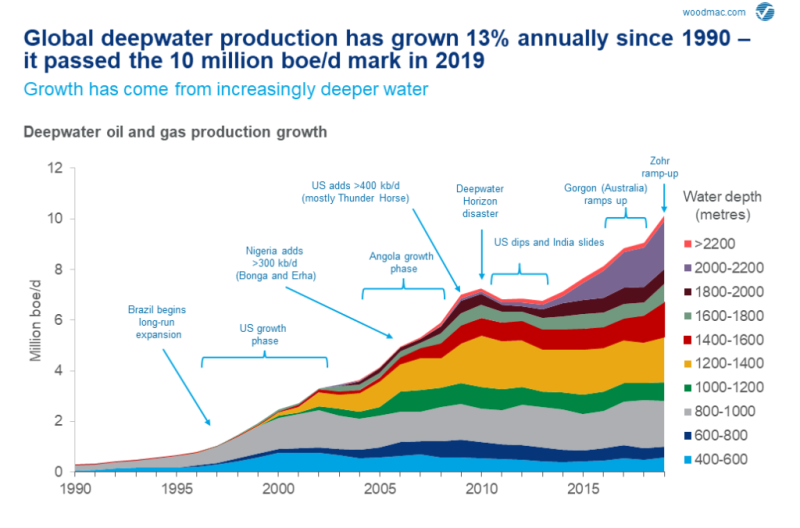Production from the world’s deepwater fields surpassed 10 million BOE/D for the first time, according to a new report from Wood Mackenzie. The energy consultancy group is forecasting that the deepwater sector is on trajectory to top 14.5 million BOE/D in the next 5 years, a figure to be driven by both oil and gas production.
“A challenging few years during the downturn forced deepwater to reinvent itself by cutting costs, cycle times, and break-evens. It has emerged much stronger and is ready for the next phase of investment—much of which will be in deeper waters and in new plays and new countries,” the company said.
Brazil is expected to lead in terms of future investments and production from the Santos Basin. Newcomers set to move the needle include Mozambique, Israel, Egypt, and Guyana.
Wood Mackenzie notes in the report that while expensive and long-cycle, deepwater projects “can be highly rewarding for those willing to take on the risks.” A typical deepwater project delivers an average return of 23%, but the consultancy adds that there is a wide spectrum of outcomes. One in five assets returns just 15%.
Smaller oil projects, including subsea tiebacks to existing production platforms, have proven to be the best deepwater investments while new gas projects have “systematically lower returns.” In the past decade, deepwater gas has accounted for 58% of the new volumes discovered—less than half of which is considered commercially viable. Wood Mackenzie expects this trend to continue despite the large number of major gas discoveries that remain on hold due to low prices and high development costs.

Deepwater Evolving
To expand its production profile, the deepwater sector is increasingly becoming the ultra-deepwater sector. Wood Mackenzie points out that in 2000 most deepwater projects involved depths of around 2,000-2,600 ft. Ultra-deepwater projects of about 5,000 ft or deeper are now outpacing these shallower projects.
The firm estimates that by 2023, ultra-deepwater will represent more than half of all deepwater production, with most of the new supplies sourced from offshore Brazil, Guyana, and the US Gulf of Mexico. The Santos basin in Brazil and the Stabroek block in Guyana are projected to add over 2.5 million B /D of oil production by 2025.
Deeper projects in more complex reservoirs will bolster output from the US Gulf of Mexico while the once-hot fields offshore west Africa are set to decline by as much as 400,000 BOE/D by 2025.
The increasing depths and technical challenges have mean that much of the industry is excluded from deepwater exploration. Today, more than 75% of deepwater production is operated by the international majors plus Petrobras. These eight companies represent 23 of the largest 25 deepwater assets.


